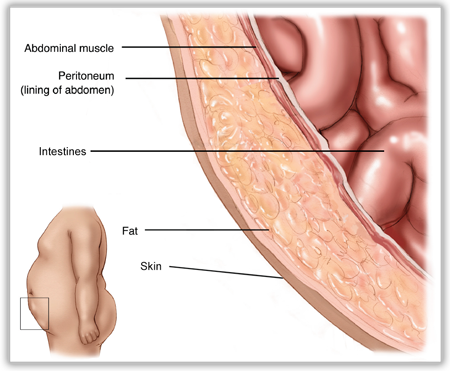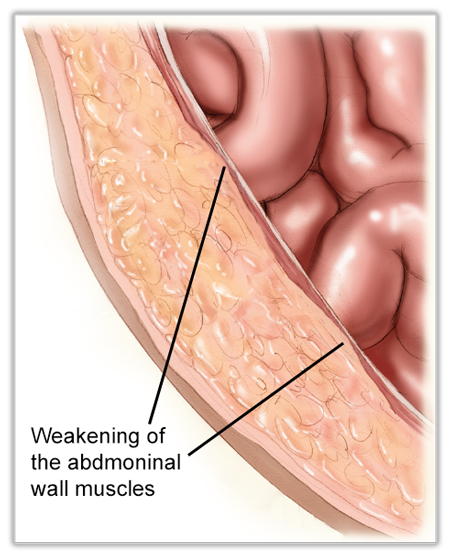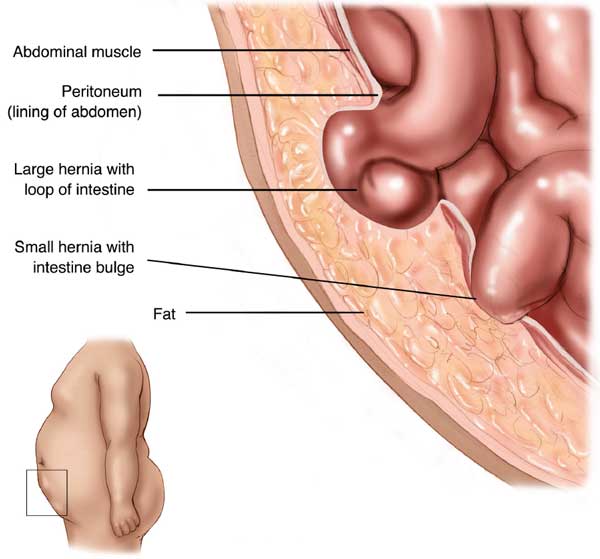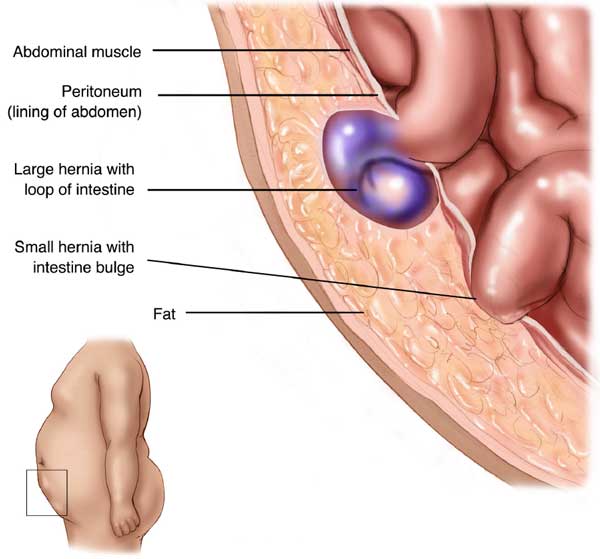The formal definition of a hernia is a protrusion of an internal organ through a wall of the cavity (as of the abdomen) in which it is normally enclosed. Patients often ask “what is a hernia?”.
That being said, actually UNDERSTANDING what a hernia is can be one of the most important aspects of having a hernia. By learning what a hernia is, patients can better decide on whether to have their hernia treated, it can assist them in choosing the best method and the best specialist for their hernia surgery, and can help in developing a clear understanding of recovery after hernia repair.
However, learning what a hernia is can be difficult. We hope that the pictures, descriptions, and video below will help walk you through developing a basic understanding of what the term “HERNIA” describes..
What is a Hernia? Step 1: The Layers of the Abdominal Wall
The first step in learning what a hernia is, is having a basic understanding of the muscles and layers of the normal abdominal wall. Everyone has the same basic layers of the abdominal wall. Starting from the outside, there is the skin. Under the skin there is a layer of fat. Below that fat there is a strong layer of muscles. This layer of muscle is what provides ALL the strength to the abdomen. Under the muscles, there is a thin lining separating the muscles from the internal organs called the peritoneum. This layer has no strength associated with it and is just a very thin layer. Under the peritoneum lies the internal organs, including the intestines, stomach, liver, etc.

These layers are essentially the same throughout the abdomen including the groins (inguinal), belly button (umbilical), or the other parts of the abdominal wall. Even patients who have had surgery and possibly have an incisional hernia have these layers in the abdomen.
What is a Hernia? Step 2: Weakening of the Abdominal Wall Muscles
In some patients, over time the muscles of the abdominal wall weaken. Initially this doesn’t cause a hernia or a hole in the muscles. However, these areas are a potential spot for hernia formation. Minimizing the risk factors for hernias (including obesity and smoking) can help reduce the chances that this weakening of the muscle will form a true hernia.

What is a Hernia? Step 3: Early Hernia Formation
Eventually a small hole or tear in the muscle forms. When internal fat or internal organs press through the hole in the muscle, a “hernia” develops. This initially starts as a small hole and may go undetected. The internal organs and fat may not cause the skin over the hernia to ‘bulge’ out. Some small hernias may not cause any pain during the initial stages. But, as the hernia slowly enlarges, it can often cause tension on the muscles and the nerves around the hole. This slow, chronic process, often results in aching, burning, throbbing, and generalized discomfort in the area of the hernia.

What is a Hernia? Step 4: Late Hernia Formation
As the hole in the muscle gets larger over time, the internal fat and intestines push further into the skin and fat. By this stage, there is usually a noticeable bulge under the skin. The nerves within the groin get stretched. This irritation in the nerve can cause pain to radiate, or be relayed to areas below or above the actual hernia. In the case of a groin hernia, this can mean pain in the lower abdomen, in the upper thigh, or into the scrotum and testes in men. Even when the hernia is reduced inside, the irritation of the nerves can lead to long standing discomfort in these areas. Even though the hernia is not in the exact area of the pain, it can be the cause of aches, pressure, burning, and other symptoms.

What is a Hernia? Step 5: Possible Strangulation and Trapped Intestine
In a rare complication of a hernia, a piece of the large or small intestine can become trapped inside of the hole in the muscle. This piece of intestine can become blocked and the blood supply cut off. This can result in a backup of food inside the intestine (bowel obstruction) and ultimately permanent injury to the intestine (strangulated bowel).

Occasionally these symptoms can be mild and intermittent. This often happens when only a small portion of the intestine is trapped inside the hernia, or when the intestine is able to pop into, and out of, the hernia on it’s own. This causes intestinal blockages on and off, leading to nausea and vomiting which comes and goes almost at will. Hernia patients with these symptoms should be seen by a hernia specialist as soon as possible.
Risk Factors for Developing a Hernia
Although most people that develop hernias have no specific ‘risk factor’, those with the following may be at an increased risk of developing a hernia:
- Being a male. Men are more likely to develop an inguinal hernia. Women can also get groin hernias, but more infrequently than males.
- Family history. The risk of developing a hernia increases if you have a close relative, such as a parent or sibling, with the a hernia.
- Chronic cough. A chronic cough, such as occurs from smoking or COPD, increases your risk of hernias.
- Chronic constipation. This leads to frequent straining during bowel movements which increases stress on the abdominal wall and increases the chances of developing a hernia.
- Being overweight. Being moderately to severely overweight puts extra stress and pressure on your abdominal muscles. Over time this can weaken the muscles and cause a hernia.
- Pregnancy. This can both weaken the abdominal muscles and cause increased pressure inside your abdomen.
- Certain occupations. Having a job that requires heavy physical labor increases your risk of developing a hernia due to the repeated stress an pressure on the abdominal muscles.
- History of hernias. If you’ve had a previous hernia, it’s more likely that you can develop another. This is usually associated with inguinal or groin hernias on the opposite side.
Introduction to Treatment Options
Once we’ve diagnosed a hernia, the next step is to determine what, if any, treatment is necessary. As we discuss in the video below, some patients may not have to undergo any treatment for their hernia. Watchful waiting is sometimes the best treatment for patients. For those patients who have symptoms and need their hernia fixed, deciding on what type of surgery to have is the next step.
What are my Options for Hernia Treatment?
Dr. Harris from California Hernia Specialists discusses the options patients have to treat their abdominal wall hernia including watchful waiting all the way to advanced laparoscopic hernia repair.You can read more on our ‘Hernia Treatment Options‘ page.














